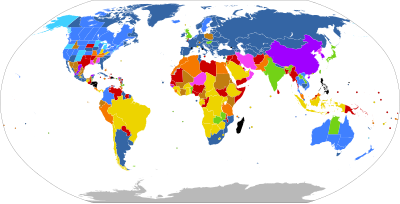
| Legal on request: | |
| No gestational limit | |
| Gestational limit after the first 17 weeks | |
| Gestational limit in the first 17 weeks | |
| Unclear gestational limit | |
| Legally restricted to cases of: | |
| Risk to woman's life, to her health*, rape*, fetal impairment*, or socioeconomic factors | |
| Risk to woman's life, to her health*, rape, or fetal impairment | |
| Risk to woman's life, to her health*, or fetal impairment | |
| Risk to woman's life*, to her health*, or rape | |
| Risk to woman's life or to her health | |
| Risk to woman's life | |
| Illegal with no exceptions | |
| No information | |
| * Does not apply to some countries or territories in that category | |
Abortion laws vary widely among countries and territories, and have changed over time. Such laws range from abortion being freely available on request, to regulation or restrictions of various kinds, to outright prohibition in all circumstances. Many countries and territories that allow abortion have gestational limits for the procedure depending on the reason; with the majority being up to 12 weeks for abortion on request, up to 24 weeks for rape, incest, or socioeconomic reasons, and more for fetal impairment or risk to the woman's health or life. As of 2022, countries that legally allow abortion on request or for socioeconomic reasons comprise about 60% of the world's population. In 2024, France became the first country to explicitly protect abortion rights in its constitution,[1] while Yugoslavia implicitly inscribed abortion rights in its constitution in 1974.[2]
Abortion continues to be a controversial subject in many societies on religious, moral, ethical, practical, and political grounds. Though it has been banned and otherwise limited by law in many jurisdictions, abortions continue to be common in many areas, even where they are illegal. According to a 2007 study conducted by the Guttmacher Institute and the World Health Organization, abortion rates are similar in countries where the procedure is legal and in countries where it is not,[3][4] due to unavailability of modern contraceptives in areas where abortion is illegal.[5] Also according to the study, the number of abortions worldwide is declining due to increased access to contraception.[3][4]
- ^ Niewiarowski, Erik (5 March 2024). "France makes abortion a constitutional right in historic vote". PinkNews. Retrieved 5 March 2024.
- ^ "As France guarantees the right to abortion, other European countries look to expand access". AP News. 5 March 2024. Retrieved 8 October 2024.
- ^ a b "Abortion Rates Similar In Countries That Legalize, Prohibit Procedure, Study Says". International Consortium for Medical Abortion (ICMA). Archived from the original on 23 March 2014. Retrieved 23 March 2014.
- ^ a b Sedgh, Gilda; Henshaw, Stanley; Singh, Susheela; Åhman, Elisabeth; Shah, Iqbal H. (13 August 2007). "Induced abortion: estimated rates and trends worldwide". The Lancet. 370 (9595): 1338–1345. doi:10.1016/S0140-6736(07)61575-X. PMID 17933648. S2CID 28458527.
- ^ Susheela, Signh; Darroch, Jacqueline E.; Ashford, Lori S.; Vlassoff, Michael (2009). Adding It Up: The Costs and Benefits of Investing in Family Planning and Newborn Health (PDF). New York: Guttmacher Institute and United Nations Population Fund. pp. 17, 19, 27.
Some 215 million women in the developing world as a whole have an unmet need for modern contraceptives ... If the 215 million women with unmet need used modern family planning methods ... [that] would result in about 22 million fewer unplanned births; 25 million fewer abortions; and seven million fewer miscarriages....If women's contraceptive needs were addressed (and assuming no changes in abortion laws) ... the number of unsafe abortions would decline by 73% from 20 million to 5.5 million.
A few of the findings in that report were subsequently changed, and are available at "Facts on Investing in Family Planning and Maternal and Newborn Health" (PDF). Guttmacher Institute. November 2010. Archived from the original (PDF) on 24 March 2012.